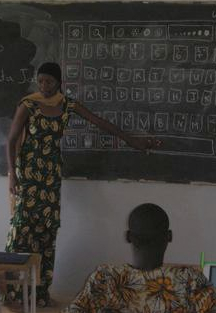More Tech Salons About ICT access
-
In the developing world, girls need new skills and capacities for the 21st Century. They need to have the ability to be flexible, adaptive, and innovative to grow into positions of influence in their communities and countries.
Yet – as we learned in the Gender Equality in ICT Education discussion – just getting girls to secondary school is a challenge, and once there, girls often shun ICT’s unless they have strong mentors and female role models.
Please join us Thursday, January 28th, as Linda Raftree, Social Media and New Technology Advisor for Plan International‘s West Africa Regional Office, leads us in a discussion of three pertinent questions:
- How can the technology and international development communities support the development of girls?
- What role does ICT play in facilitating girls’ growth?
- And where are the concrete examples that prove ICT is a net positive for female progress?
We’ll also try to identify case studies, partners, and further research around girls development and ICT for inclusion in Plan’s 2010 Girls and ICT Report, now underway.
-
In our September Technology Salon, we took on James BonTempo’s pertinent question of What Does the “m” in mHealth Really Mean? in a spirited debate with technology and development practitioners.
We were seeking a better definition of mHealth than the current focus on devices, and specifically the hype around mobile phones. As one participant bemoaned, it seems that every health project with a mobile phone or PDA, no matter their usage, is now an mHealth project.
So we sought to put parameters on what could be called an mHealth project, and through that, come up with a new definition for mHealth. After an hour of vibrant debate, we developed these four aspects for mHealth projects:
-
Last week I had the privilege to participate in the Humanitarian Technology ChallengeTechnology Partnership with the Vodafone Foundation.
Over two days, IEEE members were encouraged to develop and implement technological responses to three humanitarian challenges in developing countries:
- Reliable Electricity: Availability of power for electronic devices
- Data Connectivity of Rural District Health Offices: Capability of exchanging data among remote field offices and central health facilities
- Patient ID Tied to Health Records: Maintain consistent patient records, including when patients visit different clinics and when they relocate
Working with them were representatives of 10 humanitarian organizations, and the brainstorming sessions where technology and development experts came together to devise solutions made the conference feel like a large-scale Technology Salon.
-
There needs to be a micro mobile telco solution, an entrepreneur-led, small-scale business model to deliver connectivity to rural or underserved areas not seen as commercially viable by large GSM providers.
In this model, voice communication is the original “killer app” – the key functionality that drives early and widespread adoption and revenue. But should broadband data also be provided, even if there isn’t obvious demand?
Broadband data connectivity is needed for many applications in virtually every development sector, from e-government to e-health, and is often central to any educational intervention. And as mobile carrier backhauls are almost always IP networks, the technology it there.In fact, there was also consensus that technology was not the main micro mobile telco constraint – costs and functionality continue to develop to the advantage of potential effective solutions like WiFi mesh networks, WiMax technology, and GSM infrastructure.
-
Mobile phones are an amazing success story in the developing world, bringing transformative opportunities to many underserved communities. But they do not reach out to remote rural villages – where there is demand and purchasing power, albeit limited – and a scaleable micro mobile teclo solution could transform communications and development for the poorest of the poor.
So what might be the business and technology models that would allow entrepreneurs to roll out mobile phone systems to these underserved communities? And could development organizations play a role?
Which technology would be best: GSM? WiFi? WiMax? What’s the business case: Handset sales? Subscriptions? Airtime Only? Could voice services be augmented with data? Even broadband? How might an entrepreneur serve 400 customers at $10 per month revenue or $48,000 per annum? And should aid organizations seed these businesses?
Join David Ferguson, for a lively discussion of possible micro mobile telco models and expect to hit the whiteboards with your ideas.
-
In northern Mali, out beyond the famously remote Timbuktu, distances are vast and communication difficult. National borders often are less than lines in the sand, and the rule of law just a vague idea. In this power vacuum, bandits still hijack convoys, Tuareg stage rebellions, and terrorist organizations can take root and train.
Yet one brave organization is connecting remote Malian communities to reduce the threat of banditry or worse. Geekcorps Mali is building links between caravans, villagers, and local government – with information and communication technologies.
Geekcorps Mali has developed an innovative ICT intervention that marries FM radio broadcasting with Internet-enabled computers and digital audio recording to give a voice to local communities. The radio stations have become beacons of objective information and a de-facto early warning system for northern Mali and even the country as a whole.
-
Mobile phones have established themselves as the communication and networking platform of choice for billions of the world’s consumers, most of whom are at the base of the global economic pyramid. Worldwide, mobile phone subscribers outnumber Internet users almost 3 to 1, with much of that gap coming from skyrocketing mobile phone use in Africa, India and China.
Yet new mobile computing platforms, such as the XO laptop from One Laptop Per Child and the Asus Eee PC promise to radically change Internet access with breakthrough portability, performance, power and price. Does “4P Computing” pose a challenge to mobile phone dominance, or does each approach blend into the other?












